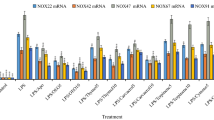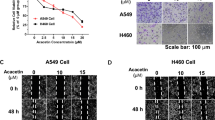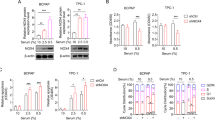Abstract
Aim:
To investigate the role of nitric oxide (NO) in oridonin-induced apoptosis and autophagy in murine fibrosarcoma L929 cells and the underlying molecular mechanisms.
Methods:
Cell viability was measured using MTT assay. Intracellular NO level, SubG1 cell ratio and autophagy cell ratios were analyzed with flow cytometry after diaminofluorescein-2 diacetate (DAF-2DA), propidium iodide (PI) and monodansylcadaverine (MDC) staining, respectively. Protein expression was examined using Western blot analysis.
Results:
Exposure of L929 cells to oridonin (50 μmol/L) for 24 h led to intracellular NO production. Pretreatment with NOS inhibitor 1400w or L-NAME inhibited oridonin-induced apoptosis and autophagy in L929 cells. The pretreatment decreased the apoptosis-related protein Bax translocation and cytochrome c release, increased Bcl-2 level, reversed the autophagy-associated protein Beclin 1 increase and conversion of LC3 I to LC3 II. Furthermore, pretreatment with NO scavenger DTT completely inhibited oridonin-induced apoptosis and autophagy in L929 cells. In addition, oridonin (50 μmol/L) activated ERK and p53 in L929 cells, and the interruption of ERK and p53 activation by PD 98059, pifithrin-α, or ERK siRNA decreased oridonin-induced apoptosis and autophagy. The inhibition of NO production reduced oridonin-induced ERK and p53 activation, and NO production was down-regulated by blocking ERK and p53 activation.
Conclusion:
NO played a pivotal role in oridonin-induced apoptosis and autophagy in L929 cells. Taken together with our previous finding that ERK contributes to p53 activation, it appears that NO, ERK, and p53 form a positive feedback loop. Consequently, we suggest that oridonin-induced apoptosis and autophagy are modulated by the NO-ERK-p53 molecular signaling mechanism in L929 cells.
Similar content being viewed by others
Log in or create a free account to read this content
Gain free access to this article, as well as selected content from this journal and more on nature.com
or
References
Palmer RM, Ferrige AG, Moncada S . Nitric oxide release accounts for the biological activity of endothelium-derived relaxing factor. Nature 1987; 327: 524–26.
Strijdom H, Chamane N, Lochner A . Nitric oxide in the cardiovascular system: a simple molecule with complex actions. Cardiovasc J Afr 2009; 20: 303–10.
Gu Z, Nakamura T, Lipton SA . Redox reactions induced by nitrosative stress mediate protein misfolding and mitochondrial dysfunction in eurodegenerative diseases. Mol Neurobiol 2010; 41: 55–72.
Ridnour LA, Thomas DD, Switzer C, Flores-Santana W, Isenberg JS, Ambs S, et al. Molecular mechanisms for discrete nitric oxide levels in cancer. Nitric Oxide 2008; 19: 73–6.
Kezoe T, Chen SS, Tong XJ, Heber D, Taguchi H, Koeffler HP . Oridonin induces growth inhibition and apoptosis of a variety of human cancer cells. Int J Oncol 2007; 23: 1187–9.
Taatjes DJ, Sobel BE, Budd RC . Morphological and cytochemical determination of cell death by apoptosis. Histochem Cell Biol 2008; 129: 33–43.
Elmore S . Apoptosis: a review of programmed cell death. Toxicol Pathol 2007; 35: 495–516.
Levine B, Mizushima N, Virgin HW . Autophagy in immunity and inflammation. Nature 2011; 469: 323–35.
Chen N, Debnath J . Autophagy and tumorigenesis. FEBS Lett 2010; 584: 1427–35.
Lleo A, Invernizzi P, Selmi C, Coppel RL, Alpini G, Podda M, et al. Autophagy: highlighting a novel player in the autoimmunity scenario. J Autoimmun 2007; 29: 61–8.
Morselli E, Galluzzi L, Kepp O, Vicencio JM, Criollo A, Maiuri MC, et al. Anti- and pro-tumor functions of autophagy. Biochim Biophys Acta 2009; 1793: 1524–32.
Kabeya Y, Mizushima N, Ueno T, Yamamoto A, Kirisako T, Noda T, et al. LC3, a mammalian homologue of yeast Apg8p, is localized in autophagosome membranes after processing. EMBO J 2000; 19: 5720–8.
Huang J, Wu L, Tashiro S, Onodera S, Ikejima T . A comparison of the signal pathways between the TNF alpha- and oridonin-induced murine L929 fibrosarcoma cell death. Acta Med Okayama 2005; 59: 261–70.
Cheng Y, Qiu F, Huang J, Tashiro S, Onodera S, Ikejima T . Apoptosis-suppressing and autophagy-promoting effects of calpain on oridonin-induced L929 cell death. Arch Biochem Biophys 2008; 475: 148–55.
Cheng Y, Qiu F, Ye YC, Tashiro S, Onodera S, Ikejima T . Oridonin induces G2/M arrest and apoptosis via activating ERK-p53 apoptotic pathway and inhibiting PTK-Ras-Raf-JNK survival pathway in murine fibrosarcoma L929 cells. Arch Biochem Biophys 2009; 490: 70–5.
Thomas DD, Espey MG, Ridnour LA, Hofseth LJ, Mancardi D, Harris CC, et al. Hypoxic inducible factor 1alpha, extracellular signal-regulated kinase, and p53 are regulated by distinct threshold concentrations of nitric oxide. Proc Natl Acad Sci U S A 2004; 101: 8894–9.
Chan WH . Photodynamic treatment induces an apoptotic pathway involving calcium, nitric oxide, p53, p21-activated kinase 2, and c-Jun N-terminal kinase and inactivates survival signal in human umbilical vein endothelial cells. Int J Mol Sci 2011; 12: 1041–59.
Gumpricht E, Dahl R, Yerushalmi B, Devereaux MW, Sokol RJ . Nitric oxide ameliorates hydrophobic bile acid-induced apoptosis in isolated rat hepatocytes by non-mitochondrial pathways. J Biol Chem 2002; 227: 25823–30.
Ye YC, Yu L, Wang HJ, Tashiro S, Onodera S, Ikejima T . TNFα-induced necroptosis and autophagy via supression of p38-NF-κB survival pathway in L929 cells. J Pharmacol Sci 2011; 117: 160–9.
Knott AB, Bossy-Wetzel E . Nitric oxide in health and disease of the nervous system. Antioxid Redox Signal 2009; 11: 541–54.
Pacher P, Beckman JS, Liaudet L . Nitric oxide and peroxynitrite in health and disease. Physiol Rev 2007; 87: 315–424.
Yuan H, Perry CN, Huang C, Iwai-Kanai E, Carreira RS, Glembotski CC, et al. LPS-induced autophagy is mediated by oxidative signaling in cardiomyocytes and is associated with cytoprotection. Am J Physiol Heart Circ Physiol 2009; 296: H470–9.
Cheng Y, Qiu F, Ye YC, Guo ZM, Tashiro S, Onodera S, et al. Autophagy inhibits reactive oxygen species-mediated apoptosis via activating p38-nuclear factor-kappa B survival pathways in oridonin-treated murine fibrosarcoma L929 cells. FEBS J 2009; 276: 1291–306.
Lee YJ, Cho HN, Soh JW, Jhon GJ, Cho CK, Chung HY, et al. Oxidative stress-induced apoptosis is mediated by ERK1/2 phosphorylation. Exp Cell Res 2003; 291: 251–66.
Wang J, Whiteman MW, Lian H, Wang G, Singh A, Huang D, et al. A non-canonical MEK/ERK signaling pathway regulates autophagy via regulating Beclin 1. J Biol Chem 2009; 284: 21412–24.
Vousden KH, Lane DP . p53 in health and disease. Nat Rev Mol Cell Biol 2007; 8: 275–83.
Giustarini D, Milzani A, Colombo R, Dalle-Donne I, Rossi R . Nitric oxide and S-nitrosothiols in human blood. Clin Chim Acta 2003; 330: 85–98.
Snyder CM, Shroff EH, Liu J, Chandel NS . Nitric oxide induces cell death by regulating anti-apoptotic Bcl-2 family members. PLoS One 2009; 4: e7059.
Yamazaki M, Chiba K, Mohri T . Fundamental role of nitric oxide in neuritogenesis of PC12 cells. Br J Pharmacol 2005; 146: 662–9.
Brynczka C, Merrick BA . Nerve growth factor potentiates p53 DNA binding but inhibits nitric oxide-induced apoptosis in neuronal PC12 cells. Neurochem Res 2007; 32: 1573–85.
Jutooru I, Chadalapaka G, Sreevalsan S, Lei P, Barhoumi R, Burghardt R, et al. Arsenic trioxide downregulates specificity protein (Sp) transcription factors and inhibits bladder cancer cell and tumor growth. Exp Cell Res 2010; 316: 2174–88.
Ferdinandy P, Schulz R . Nitric oxide, superoxide, and peroxynitrite in myocardial ischaemia-reperfusion injury and preconditioning. Br J Pharmacol 2003; 138: 532–543.
Chen N, Karantza-Wadsworth V . Role and regulation of autophagy in cancer. Biochim Biophys Acta 2009; 1793: 1516–23.
Eskelinen EL, Saftig P . Autophagy: a lysosomal degradation pathway with a central role in health and disease. Biochim Biophys Acta 2009; 1793: 664–73.
Sohn D, Graupner V, Neise D, Essmann F, Schulze-Osthoff K, Janicke RU . Pifithrin-alpha protects against DNA damage-induced apoptosis downstream of mitochondria independent of p53. Cell Death Differ 2009; 16: 869–78.
Acknowledgements
This study was supported by the National Key Scientific Project for New Drug Discovery and Development, (2009ZX09301-012), 2009-2010, China.
Author information
Authors and Affiliations
Corresponding author
Additional information
Supplementary figures are available at the Acta Pharmacologica Sinica website.
Supplementary information
Supplementary information, Figure 1S
The cells were treated with 50 μM oridonin for the indicated time periods, followed by Western bolt analysis of Bax, Bcl-2 and cytochrome c after oridonin-treated. (DOC 1306 kb)
Supplementary information, Figure 2S
The cells were treated with 50 μM oridonin for the indicated time periods, then lysed in nuclear and cytoplasmic extraction kit accrading to the instruction (CWBIO, Beijing, China), then followed by Western bolt analysis of p53 levels. (DOC 1306 kb)
Rights and permissions
About this article
Cite this article
Ye, Yc., Wang, Hj., Xu, L. et al. Oridonin induces apoptosis and autophagy in murine fibrosarcoma L929 cells partly via NO-ERK-p53 positive-feedback loop signaling pathway. Acta Pharmacol Sin 33, 1055–1061 (2012). https://doi.org/10.1038/aps.2012.53
Received:
Accepted:
Published:
Issue date:
DOI: https://doi.org/10.1038/aps.2012.53
Keywords
This article is cited by
-
Natural agents mediated autophagic signal networks in cancer
Cancer Cell International (2017)



